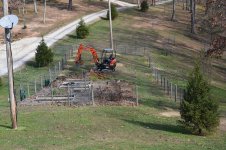EddieWalker
Epic Contributor
I have 11 acres fenced in with three rows of electric fence to keep my horses in, and the wild pigs, coyotes and racoons out. The deer just jump over it like it's not there.
If you go with electric, the number of ground rods you need will be based on your soil type and how much moisture it holds. Your wire is the positive, the soil is your ground. For the fence to work, the animal, or person, needs to be standing on the soil and connected the circuit by touching the wire. If there isn't enough current in the soil, nothing will happen. This might not be technically correct, but it's how I think of it.
If there isn't enough current going through your soil, you will need more ground rods. I have three ground rods that are ten feet apart and connected to each other with a bare copper wire to the tops of each ground rod, one after another. This works well for my red clay soil.
If you need more, then you have to run a ground wire to the half way point of your fence and install more ground rods there. You need to carry the current to the soil with the ground wire, and then into the soil with the ground rods.
If you go with electric, the number of ground rods you need will be based on your soil type and how much moisture it holds. Your wire is the positive, the soil is your ground. For the fence to work, the animal, or person, needs to be standing on the soil and connected the circuit by touching the wire. If there isn't enough current in the soil, nothing will happen. This might not be technically correct, but it's how I think of it.
If there isn't enough current going through your soil, you will need more ground rods. I have three ground rods that are ten feet apart and connected to each other with a bare copper wire to the tops of each ground rod, one after another. This works well for my red clay soil.
If you need more, then you have to run a ground wire to the half way point of your fence and install more ground rods there. You need to carry the current to the soil with the ground wire, and then into the soil with the ground rods.
